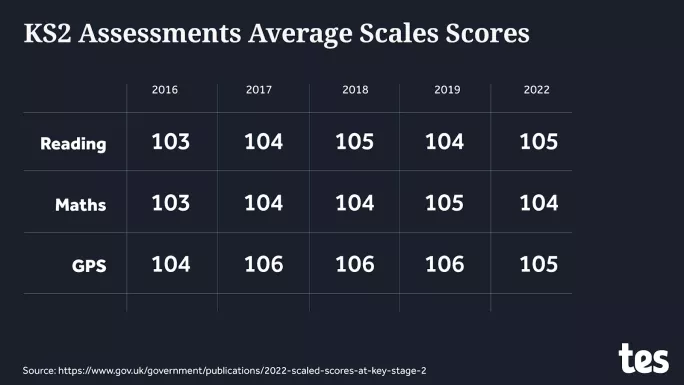KS2 Sats results: what secondary leaders need to know

Secondary leaders reading the KS2 Sats headlines must have felt daunted at the thought of welcoming their new Year 7s in September. The message was clear: the students are behind and in need of catching up.
This is a narrative that has been repeated for months, with some going as far as to say that these young people aren’t ready for secondary school.
However, it can be argued that in fact, these results aren’t all bad news.
It might seem almost sacrilegious to say it, but I’m going to suggest something rather tentatively: I don’t think the education of primary-aged children has suffered as much as we think it has.
I’ve had this suspicion for a while, and with the publication of the Sats results, this first round of hard data seems to support the hypothesis.
The story of the scaled scores
Take the average scaled scores, for example. When compared with previous years, are you able to spot which year is the “lockdown” cohort?

This data actually tells secondary leaders that the incoming cohort is more able than the 2016 cohort.
Of course, that doesn’t mean the pupils are without gaps in their learning. But whether or not we close these gaps will be decided by the approach taken in secondary school.
Sats and secondary schools
So let’s consider the breakdown for each subject. The percentage of those reaching the expected standard in KS2 maths this year was 71 per cent, compared with 79 per cent in 2019.
But what does this drop of eight percentage points tell secondary school leaders? Because the average scaled score for maths has only dropped by one point, it is likely those eight percentage points represent a group of children who would always struggle to reach the expected standard. In previous years they would have squeaked over the line, but this year they stopped just short of it.
For example, it could be that these children missed the pass mark by 1-5 marks, and in only a couple of content domains. Or even as close as missing out by a single mark on each domain.
It is a similar story when it comes to the literacy results. In the reading assessment, the increased number of children reaching the expected standard tells us there has been an improvement in performance.
The results of the grammar, punctuation and spelling tests combined with the teacher-assessed writing results suggest we have a cohort that has fared well given the difficulties faced.
However, it is worth remembering that even if maths results had matched those of 2019, reaching the expected standard actually means incorrectly answering 48 per cent of the questions.
Secondary leaders should be mindful of this statistic, especially given that the majority of the paper is testing students on content that they encountered in Years 3, 4 and 5.
What tools can secondaries reach for?
When all of the nuance of the above is taken into account, it is clear that the solution isn’t to lay on blanket interventions or try to run catch-up sessions in the hope that these gaps are closed.
Each child will have different gaps in their knowledge that need to be addressed individually, not en masse.
Helping the ‘almost there’ learners
Given our limited resources, one of the most powerful levers we have is retrieval practice, which we should use to prioritise specific gaps, practising the weakest areas as close to every day as possible. Online “deliberate practice” tools, such as Hegarty Maths, could also play a huge part in focusing our response, potentially doubling the time that children spend working on gaps.
And when it comes to writing, the results might look worrying, but it’s important to remember that they were teacher-assessed, and there was definitely a nervousness when assessing at the expected level.
The data from No More Marking suggests the focus should be on careful sentence construction and avoiding run-on sentences. Secondary English leads might consider delaying extended writing tasks while this knowledge is revisited.
Speaking and listening, the foundation of all writing, also took a very big hit in these pupils’ formative years as writers. This is something that urgently needs addressing, and secondary leads may wish to review their plans to introduce more opportunities for their learners to develop as speakers to aid their writing.
Consider the whole-school experience
Finally, we must not forget what is hidden from the KS2 data. It is quite possible that many Year 6 children had their curriculum reduced this year, with a heavy focus on maths and English. Cultural capital was another victim of the pandemic, with trips, workshops, assemblies and performances all cancelled - vital ingredients for articulate, world-aware Year 7s.
It will therefore be vital for secondaries to put experiences at the forefront of their offer. This, in conjunction with a greater focus on oracy, sentence construction and laser-focused retrieval practice, will give this cohort a fighting chance.
What is the bigger picture?
Of course, it is good and right that secondaries make these adjustments, and consider how this year’s cohort will be slightly different from other years. However, the extra focus on the KS2 assessments is a welcome spotlight, as it has revealed some of the issues facing primary schools that have existed for some time.
Even before the pandemic, the real problem is the primary curriculum itself.
Its sheer size discriminates against those with lower working-memory capacity (or processing power). It’s not that they can’t learn everything, it’s that there isn’t enough time for them to do so. But it’s statutory, so we plod on regardless.
How much progress these young people make when they reach secondary school really matters, as the data tells us these young people almost never catch up. In the Department for Education paper Understanding KS4 attainment and progress, they describe the KS2 results as “a strong predictor of attainment” for KS4.
But what does this mean in practice? It means the young people who leave primary school far behind their peers stay there. Whatever we’re doing at the moment isn’t working.
Now, more than ever, we should re-examine why they fail and make root-and-branch changes to ensure we aren’t failing pupils and meet the needs of all.
Solomon Kingsnorth is a primary school teacher and senior leader who blogs on education policy
You need a Tes subscription to read this article
Subscribe now to read this article and get other subscriber-only content:
- Unlimited access to all Tes magazine content
- Exclusive subscriber-only stories
- Award-winning email newsletters
Already a subscriber? Log in
You need a subscription to read this article
Subscribe now to read this article and get other subscriber-only content, including:
- Unlimited access to all Tes magazine content
- Exclusive subscriber-only stories
- Award-winning email newsletters
topics in this article



